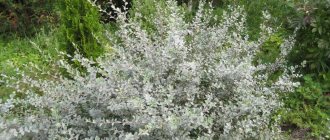Growing willow in the garden - types and varieties with photos, care, cuttings and diseases
The genus of willow or willow (Salix) is extremely numerous and difficult to classify.
Its species easily cross-pollinate with each other, creating numerous hybrids that are often difficult to identify. About 400 representatives of the genus are known, of which only a few are widely used in landscape gardening. In addition to being unpretentious and easy to care for, decorative willow is represented by dozens of picturesque varieties - trees and shrubs that, after planting, fit into any garden design; most of them do not lose their attractiveness for many years.
Popular types and varieties of standard larches
The popularity of larches on a trunk is based on the unique ability of plants to shed needles in the fall and renew them in the spring. The varieties have high decorative value in landscape design and decoration of summer cottages.
Did you know? Larch is a long-lasting crop. Its life span can be 600 years.
For growing at home, most gardeners prefer low-growing varieties. They carefully and subtly emphasize landscape compositions of any style. Varieties of standard larches are obtained by grafting the crown of the plant. The height of the trunk is 1.5–2 m.
Weeping
After grafting, the weeping larch has an even trunk and branches falling to the ground. Its height can be from 1 to 8 m. This depends on the height at which the tree was grafted. The diameter of the trunk is up to 1.5 m.
The shoots of the plant are covered with thick needles. Needles can be different shades of green. The seeds ripen in female and male cones. Women's ones are especially beautiful because they have a bright color. They fall off in the fall along with the needles.
Did you know? Larch is able to grow in cold regions and withstand temperatures of -70°C.
European
European larch prefers rocky soils and does not tolerate marshy soils. In the wild, the variety lives on rocks and mountains. The branches are strewn with thick soft needles. They descend to the ground, resembling a willow tree. The crown shape is oval. The bark has a brown-brown tint. In young trees it is gray in color.
Pendula
Pendula was bred in 1836. It immediately gained extraordinary popularity due to the decorative features of the species, which is ideal for group and single plantings. The height of Pendula does not exceed the height of the trunk. On average, it is 1.5 m. The width of the crown can reach 1 m. The needles have a bluish tint. The color of the male and female buds is bright: the former have a golden hue, the others a rich red. The shape of the crown looks like lace.
Bullets
The Puli variety is characterized by creating a natural curtain of branches. It has pale green needles that grow in bunches. It descends to the ground in the form of weeping shoots. The cones are 3 cm long and have a round, ovoid shape.
Repens
The Repens variety captivated designers with its thick and lush crown. The branches carefully tend to the ground, sometimes spreading out over it like a green carpet. The color of the needles is rich and bright green.
Description of willow with photo
Fast-growing and easy to grow, deciduous willows can take on a variety of forms depending on their growing zone - from dwarf and creeping shrubs to large, stately trees.
Blooming garden willow
Willow leaves are most often narrow, lanceolate, but can also be elliptical or almost round, smooth or slightly pubescent. In spring, plants are attracted by decorative fluffy male inflorescences-catkins, popularly known as “seals”.
Some inflorescences are very large, almost 6 cm in length. They can be golden, reddish or silver in color, depending on the variety of willow. Willow flowers are honey-bearing. Willow is one of the earliest flowering plants, and its pollen and nectar are the first food for bees after winter.
Due to the ability to form adventitious roots, the plant is very easily propagated using cuttings, but the seed material is viable for only a few days, after which the seeds lose their viability.
Varieties and types of willow with photos
Numerous varieties of garden species have high decorative characteristics and can be used in any landscape style.
For example, some cultivars of shrub willow are valued for their bright shoots, similar in color and texture to turf, while other varieties are attractive for their interesting growth form or spectacular cat flowers.
Almost every garden species is represented by the “Pendula” form with weeping shoots. More recently, the plant has become an important source of bioenergy production and a representative of ecosystem gardening.
Whole-leaved willow (Salix integra) is a shrub, up to 2–6 meters high. One of the most famous varieties of this species is the variegated Japanese willow “Hakuro Nishiki”. The cultivar is a winner of the prestigious Award of Garden Merit from the Royal Horticultural Society.
Willow "Hakuro Nishiki" is usually grown in the form of a miniature tree on a trunk 1.5 meters high. Its main decorative value is its colorful foliage.
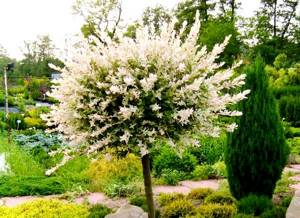
Willow "Hakuro Nishiki" in landscape design
New spring leaves are colored white-cream, pale pink and light green and remain so for most of the season. Mature leaves gradually lose their pink tones.
The shoots are quite stiff, raised, and can have a red or orange-yellow tint, thanks to which the tree remains a bright accent in the garden throughout almost the entire year.
Growing Hakuro-Nishiki in containers is quite popular today. This is an interesting offer for those who are looking for spectacular and easy-to-care plants.
The variety of this type of willow "Flamingo" was obtained from "Hakuro Nishiki" and is characterized by a darker pink hue of foliage. The "Pendula Waterfall" form of this species is an elegant dwarf tree with drooping shoots and slightly curled leaves.
Weeping willow or Babylonian willow (Salix babylonica) is native to China. It was first described in the twenties of the last century in France. It is a medium to large tree with a graceful weeping form of numerous, slender shoots.

Weeping willow
Slender willow (Salix gracilistyla) . In gardening, its decorative varietal form “Mount Aso” is valued, also known as Japanese pink willow.
In spring, the thin shoots of the bush are covered with large pink-red catkins, after which beautiful bluish-gray leaves appear after flowering.

"Mount Aso"
Creeping willow (Salix repens) is widespread along the banks of reservoirs and rivers in Western and Northern Europe. This is a small shrub species, reaching 1-1.5 meters in height with small, bluish, slightly pubescent leaves.
In changing conditions, the species is able to change its growth form from vertical to creeping. In gardening, the variety “Argentea” is popular, which is often sold on a standard and “Nitida”.

"Argentea"
Matsudana willow (Salix matsudana) is a medium-sized, upright, fast-growing tree native to northeastern China and Korea. The species is named after the Japanese botanist Sadahisa Matsuda.
In gardening, you can find the most common cultivar - the twisting willow "Tortuosa" with outstanding decorative value throughout the year.

Twisty willow "Tortuosa"
The variety owes its popularity to its spirally curved and twisted leaves and shoots, forming a compact, round, graceful crown. This species is not entirely hardy, so choose a warm place protected from the wind to plant willow.
Purple willow (Salix Purpurea) is a deciduous shrub reaching 1-3 meters in height. The shoots are thin, shiny, reddish, while the leaves are quite wide, gray-green.
Catkin cats are often purple or red in color. Once rooted, it gives a structural effect comparable to the strength of a stone wall, which is why it is used to strengthen slopes.
Iva Hakuro Nishiki - planting, care and propagation
In nature, whole-leaved willow grows in damp meadows, valleys, and river banks. On your site, Hakuro Nishiki will also prefer a well-moistened area, perhaps near bodies of water (but without a close groundwater level and, especially, without stagnant water!). The place should be sunny, protected from drafts, the soil should not be the lightest, preferably loam without a high lime content. On light soils, this willow can shed its leaves prematurely, and on heavy clay soils it will require the gardener to install mandatory drainage from crushed stone or sand in a layer of at least 20 cm.
- What kind of soil is on your site - how to determine and improve the composition of the soil
Do litmus tests show acidity incorrectly? Are you worried about the presence of dense lumps? Find out if everything is okay with the soil at your summer cottage!
Despite the fact that the Asian guest has completely acclimatized to our conditions, its size and growth rate directly depend on the amount of light and heat - the more of them, the taller and larger the willow will be.
Hakuro nishiki seedlings are planted in the ground in April-May. Before planting, it is worth soaking the root system of young plants in water for several hours. The depth and width of the planting hole for this willow is 40-60 cm, the distance between seedlings is 1-2 m, depending on your design idea.
- How much space does each perennial need (planting schemes)
To prevent decorative plantings from looking bald or too dense, perennials and shrubs must be planted at a certain distance.
In addition to the drainage layer, it is worth adding a layer of organic fertilizers (compost, humus) to the planting hole.
Having placed the Hakuro Nishiki seedling in the center of the prepared planting hole, carefully fill it with the prepared soil mixture of leaf soil and peat with sand. Seal the planting site, water it abundantly, and mulch to a depth of 5-10 cm.
- How to mulch the tree trunk?
In order to mulch the tree trunk correctly, you just need to observe nature: what materials usually cover the roots of the tree. Let's look at the different options.
Hakuro Nishiki willow is very resistant to diseases and pests, so its main care usually comes down to regular watering (especially in young years and later during dry periods) and timely fertilizing (two or three of them per season are enough). Long-acting complex granular fertilizer for garden shrubs gives good results. In summer, the willow can be additionally fed by foliar feeding.
As a preventative measure in the spring, Hakuro Nishiki should be treated with some systemic fungicide.
- Calendar for garden treatment against diseases and pests
Plan of protective measures in the garden.
The tree's winter hardiness is average, so it needs winter shelter, at least in the first years. If snowless, cold winters are frequent in your region, it may be worth choosing the option of growing Hakuro Nishiki not on a tree trunk, but in the form of a more cold-resistant rooted shrub. The most vulnerable to low temperatures in a standard tree is the grafting site itself, so during the winter it must be carefully wrapped in non-woven, breathable material. If freezing of the shoots does occur, simply remove the dead branches in the spring.
General characteristics of the shrub
The plant belongs to the willow family and is correctly called bredina. Among the people, the tree received its name because its foliage became the favorite food of goats and sheep . Another common name is rakita. Throughout the year, the tent-shaped weeping shrub looks very attractive: soft seals cover the shoots in the spring, which are then filled with dense foliage and beautiful yellow flowers until autumn; in winter, against the background of snow, even bare shoots from greenish-gray to red-brown color attract attention.
The tree has an average size of 3 to 10 meters in height and a powerful, branched root system. The homeland of pendula is Europe, but it has taken root well in many other parts of the world, including Russia. Life expectancy is on average 30−40 years, but sometimes reaches 150 years. The shoots are long, weaving, cascading down to the ground - this is precisely what is of decorative value in goat willow.
Types of nonsense
Botanists classify the plant as a tree or tree-like shrub. Loves light, unpretentious in the choice of soil. Today, the following varieties of goat willow are distinguished:
- Pendula - reaches about 3 m in height, characterized by a wide weeping crown, dark green foliage, elliptical shape 8-10 cm. Looks great on a trunk. Life expectancy is short - up to 30 years. Loves abundant watering, takes root in any soil, especially well near water bodies. It fits perfectly into the landscape both alone and in a group. The proximity of conifers decorates the composition. In care, pruning of shoots is important; only proper formation of the bush in the first year of life will create the required exterior.
- Kilmarnock is a miniature tree, its height is only 1.5 m. It loves light, tolerates frost well, and grows on any soil. Does not like excess moisture; watering should be moderate.
- Mas - has a spreading crown and reaches 10 m in height.
Solitaire and group plantings of willows
A free-standing Norway willow is formed into an umbrella shape by pruning the branches that descend to the bottom. It has been growing for 70 years. Bamboo-shaped forms were developed: “Record”, “Improved Schwerin”. Such willows are planted in small groups.
They look picturesque in groups of 3 - 4 pieces. brittle willow. A tree with an almost regular spherical shape. The trunk bark is dark. The shoots are bright green. The leaves are elongated, smooth with a point at the end. Effective without foliage. It grows poorly on sand, but on improved soils its decorative qualities are clearly expressed. Very frost-resistant species. Reaches a height of 20 m, maximum age is 50 years. Because of the beautiful “legs” of small shoots on the branches of the trunks, brittle willow is also called bubble willow (Bullata).
The species Goat willow (Salix caprea Silberglanz) is distinguished by the interesting color of its inflorescences: the spring catkins are white and heavily pubescent. Thanks to the hairs on the leaves, it turns silver in the light. Looks impressive against the background of dark junipers and spruce trees. Does not propagate by cuttings. But, nevertheless, this species has produced the largest number of varieties and hybrids. The weeping variety on the rootstock looks like a fountain with its long branches lowered to the ground. A common dwarf plant. Umbrella and spherical forms on high trunks with variegated leaves are interesting because of their three-color color: on each leaf a whitish field, a pink stripe and a milky green edging are visible. Variegated goat willow (variegate). There are round-leaved and oval-leaved goat willow hybrids. The densely planted, fleshy leaves of these hybrids look more like magnolia leaves and bear little resemblance to willow leaves.
Such dense corollas on stems will become successful accents on both sides of the entrance, a large plant among the flower garden.
Twisty Willow Ural - the tree is not tall, up to 3.5 m. Similar to its heat-loving counterpart - Matsuda willow . The ornateness of the new variety is observed both in the branches and in the leaves, even in the inflorescences.
Low, several-centimeter willows (polar Salix polaris, herbaceous Salix herbacea ), their varieties and hybrids are planted on rocky hills and mixborders along walking alleys.
In combination with spruce and birch trees, decorative willows look especially convincing. Landscape designers using willows are reviving the traditions of the Russian style in landscaping.
aquagroup.ru
Tree propagation and cultivation
Propagated by seeds, grafting and cuttings. Seeds must be used after 10 days of ripening, otherwise germination is lost. Flowering begins in April with golden earrings about 10 cm long and lasts about 2 weeks. In May the fruit is formed. It has the shape of a box measuring 8 cm, which contains up to 20 seeds with fluffy growths.
It is easier to root a tree by cuttings. To do this, cut branches at least 10 cm long should be placed in a bucket for several days. It is necessary to make good drainage in the hole , fertilize it with compost, place the cutting, bury it and provide abundant watering.
The crown should be formed immediately by cutting off the lower branches; the growth bud should always be directed outward.
Not every gardener can graft onto a standard tree. This is a rather complex process that requires certain knowledge and skill. Goat willow on a trunk does not take root in all varieties. Pendula is best suited for this. The original trunk can also be used as a standard. Subsequently, you need to monitor the kidney very carefully so that it does not appear below the grafting site. If this happens, then the kidney must be removed.
The best option would be to purchase a ready-made seedling from a nursery. When purchasing, you need to carefully check the tree to ensure it is healthy. The bark should be solid without cracks, and there should be no dead scales.
Soil preparation and watering
Bredina is not picky about the soil and will take root well in almost any conditions. But it will feel best on loamy soil, which is dense and retains moisture well. In spring, for planting you will need a hole 40 cm deep and 50 cm wide (to fit the entire root system). At the bottom of the hole you need to make good drainage, then fill 1/3 with earth or better such a mixture; Combine compost, humus and peat in a 1:1 ratio; you can also add a little sand. For growth, feed with nitrogen fertilizer, then place the seedling in the center and bury it.
How to properly form a willow tree on a trunk
Goat willow on the Pendula trunk has recently become extremely popular in gardens. Gardeners like the unusual shape of the plant, its decorative appearance, the ability to shape the tree at their own discretion, as well as its compactness.
In order for a willow on a trunk to retain its height and shape for a long time, it must be trimmed correctly. Otherwise, the branches will not grow at all the way you want, they will lie in a shapeless mass on the ground,
and the willow will lose its decorative effect. Correcting the shape of the tree in the future will not be easy.
I’ll tell you about my experience of forming Pendula willow on a trunk. At the end of the article, I’ll share how to add some flair to your willow tree.
When to prune?
Pendula goat willow should be pruned in the spring after flowering. It blooms from late April to May, about two weeks. Golden-yellow catkins bloom on the tree. Earlier pruning will deprive you of this beauty.
Therefore, we prune the willow around the beginning of May, when it fades and the catkins begin to fall off.
How to trim?
Willow requires quite drastic pruning. So let’s remove the pruning shears and shorten the shoots. We leave short “stumps” 10-15 cm long with several pairs of buds.
What must be taken into account when pruning?
The main thing is to cut to the bud that on the branch looks not down or into the center of the crown, but up (or at least to the side).
The shoot from such a bud will curve beautifully as it grows.
Don’t worry, the willow will not last long in such an unsightly form. Rapidly growing branches will soon give it a presentable appearance, and such a drastic pruning will only benefit the tree.
But do not forget to water and feed the willow generously after cutting.
How much pruning should you do over the summer?
The tree may need formative pruning in the future, and more than once. Within a month or a month and a half, the branches of your willow, especially if the trunk is not high, will begin to lie on the ground.
They can be shortened. Summer pruning of branches will cause other buds to wake up, and your tree will soon begin to branch even more.
Over the summer, new shoots, if not pruned, can grow up to 3 meters long or even more. They will crawl on the ground.
Each subsequent shortening of the shoots will stimulate the growth of new shoots from the higher buds. So Pendula will look like a ball, an umbrella or a candelabra. In spring, such strong shoots will definitely bloom.
How to make it decorative?
Some gardeners deliberately strip the curved tops of branches of leaves to show the pattern created by the branches.
Decoration of a summer cottage goat willow
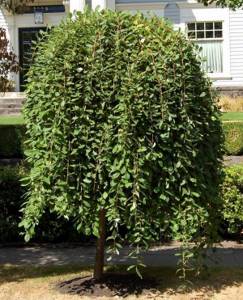
Goat willow, otherwise botanists call it Bredina (Selix carrea), and in common people it is simply Rakita, a plant belonging to the Willow family. Europe is considered its homeland, but it grows successfully in Western Asia, the Caucasus and Central Asia. The average life expectancy is 150 years. During this time, the height of the plant can reach 10 m and 0.75 m in trunk diameter.
Many gardeners wonder whether goat willow is a tree or a shrub? Everyone calls it differently, but in general classification it is a deciduous tree, sometimes a tree-like shrub. Based on the name, we can conclude that sheep and goats like to feast on the plant.
Short description

The plant loves light, however, it has shade-tolerant qualities. Favorite growing areas: fertile, rich, sandy or gravelly soils. At the same time, they should not be very wet - this can destroy the tree. As a conclusion, watering should be moderate. Broom is found along roads, houses, in forest clearings, and clearings. Formed seedlings are used for planting. If you need to propagate, then cuttings, seeds or a grafting method are suitable for this.
The characteristic features of the plant are:
- Branches . They are thick and spreading. In young individuals they have a slightly grayish color and slight pubescence. In mature and well-developed specimens, the color of the branches may be greenish-gray or yellow-brown. If the tree is old, then its branches become gray in color and become brittle.
- Bark. At first it is green-gray in color and quite smooth. As it matures, the color changes to brown, and cracks form at the bottom of the trunk. As for wood, it is smooth, but when it comes into contact with air it turns red.
- Foliage. It has an elliptical shape with a length/width of 11-18/5-8 cm, respectively. The outer side is dark green, and the lower side is grayish. A distinctive feature is a jagged, uneven edge. The buds are hidden in the axils of the leaves. They are quite large (length-width 5/3 cm, respectively). Flower buds are reddish in color and ovoid, not flattened, measuring 15/3-6 mm in length/width.
- Flowers in the form of earrings. Goat willow blooms in April, before the foliage begins to grow, and lasts 10-13 days. There are female and male flowers. The first are wide, oblong-oval, up to 6 cm long. The second are dense, cylindrical, reach 10 cm in length, multi-flowered.
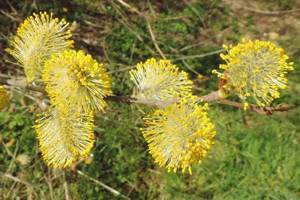
- Fetus. As a result of pollination in May, a fruit is formed in the form of a box with a diameter of about 7-8 cm, located on a fluffy petiole. Each fruit contains about 18 seeds with fluffy outgrowths, thanks to which the seeds are transferred over a distance. Unfortunately, the seeds lose their viability very quickly.
Decorative properties, description and planting of goat willow
This plant is found throughout Europe, the Caucasus, Western and Central Asia. It is not found only in the tundra and alpine forests. It is called goat willow, willow or bredina. You can often see thickets of goat willow along roads, near houses, on forest edges and clearings.
Description and characteristic features
Goat willow is a plant from the Willow family. This is a deciduous tree, reaching a height of 10 meters with a trunk diameter of up to 75 cm. Willow is often found in the form of a woody shrub. The average lifespan of a plant in the wild is 150 years.
Goat willow got its name due to the fact that its leaves and branches are a favorite treat for sheep and goats. Its favorite places to grow are fertile, rich soils with a high content of sand or crushed stone. Thanks to the branched root system, the plant takes root well on rocky soils.
Characteristic features of willow:
- Thick and spreading branches. In young plants they are grayish and slightly pubescent; in older specimens the branches acquire a greenish-gray or yellow-brown color. The branches of old willows become gray and brittle.
- Bark. In young plants it is smooth, greenish-gray. Then it becomes reddish-olive or reddish-brown, which is why the tree is also called red vine or willow. Over time, the bark at the bottom of the plant cracks. Goat willow wood turns red when exposed to air.
- Leaves. In goat willow they are oblong, lanceolate or ovate, with jagged edges, up to 18 cm long and up to 5 cm wide. The outer side of the leaves is dark green, the lower side is grayish. The buds are located in the axils of the leaves.
- The flowers are large fluffy earrings. Willow begins to bloom in April, before the leaves appear. Its flowering lasts from 10 to 13 days. Willow is a dioecious plant. It has female and male flowers: female wide, oblong, up to 6 cm long, male flowers - multi-flowered, cylindrical, up to 10 cm long. Willow is a valuable honey plant that attracts insects with the pleasant smell of flowers.
- Willow fruits have the shape of boxes with a diameter of 7-8 cm, located on a fluffy petiole. Each box contains up to 18 seeds. The seeds are equipped with fluffy shoots, thanks to which they are transported over a considerable distance.
Beauty and form

Goat willow in landscape design (photo can be seen below) is very common. And all thanks to its beauty and shape. Moreover, the appearance of the plant greatly depends on the soil in which it grows and the light level.
Most often, broom is planted when landscaping private houses and estates. At first glance, the willow seems unprepossessing, but thanks to its weeping forms, grafted onto the trunk, it acquires a very attractive appearance.
Willow also looks great in rocky gardens, as well as on the edge of ponds. It is worth appreciating another advantage of the plant - the ability to hold the soil together with its roots, so it is not surprising that it is often planted on slopes.
Willows in landscape design
Weeping willow, willow, willow, willow, willow, willow, basketweed, shelyuga, willow... All these names refer to the usual willows. Latin name: Salix. Willows appeared in the Cretaceous period, existed simultaneously with dinosaurs, but survived them due to their unpretentiousness to soils and frost resistance. More than 170 species - from Africa to the Arctic - serve people for weaving baskets, feeding livestock, in medicine, in leather tanning, and as a dye.
The beauty of willows was sung by poets and depicted on the canvases of artists, but was rarely used in landscaping.
Willows began to be actively used in landscape design in England in the 19th century, when the fashion for walking canals began. Plantings along the banks of reservoirs strengthened the shore. The stability of willows in flooded areas is known.
The wider distribution of white silver willows (Alba var. Sericea) in landscaping was hindered by the fact that they have a very dense crown. Windage is combined with the absence of a taproot. A strong wind can knock down a willow if it stands in an open area. This does not threaten young trees, but a tree aged 30-40 years often falls. In addition, all wild species of willows are extremely light-loving. Powerful, beautiful trees are usually found outside cities.
Particular attention of dendrologists to low-growing species has returned willows to streets and parks. However, Western European cultivars are poorly adapted to temperate latitudes. Heat-loving “sissies”: Iva Babylonskaya, Iva Matsuda, Iva Kanginskaya, Iva Hakuro Nishiki - despite their highest decorative qualities, they are not suitable for temperate latitudes.
Thanks to the work of Siberian breeders Marchenko and Shaburov, frost-resistant varieties with decorative qualities exceeding their Western European counterparts were obtained. The variety of forms is impressive: creeping, grass-like, drooping, spherical, bamboo-shaped, dwarf, winding, special for hedges, for basket weaving, etc. The Russian style in landscaping has received excellent planting material, and the number of its fans is increasing.
The increase in the varietal family of willows is facilitated by the own properties of the willow genus: almost every type of tree has a bush variety, cuttings easily take root on the trunk. Willow actively reproduces from a cut trunk and root splitting. Vines of 5 - 10 buds planted in the ground are regenerated without loss of varietal properties.
French winemakers invented a trellis fence for grapes. Willow branches are planted in the ground at a distance of 15 - 10 cm with a variable direction of inclination. The branches of the trunk are cut off, and the trees are tied at the crossroads. The result is a fence with diamond-shaped cells.
Wicker fences for climbing plants (Ukrainian “tyn”) look elegant. Pegs with a diameter of 2-3 cm are driven into the ground at a distance of 15 - 20 cm. Softer, thin rods are placed in the gaps, bending alternately to the left and to the right. Tall wicker fences look good. Low ones (10 - 30 cm) can serve as a retaining wall for small flower beds. They look spectacular with Violas, Armerias, Salvias, Poppy Sadov. The wattles, having dried out, are destroyed slowly, and when destroyed, they improve the soil.
For Beans, Peas, climbing Hedgehog Fruit, Morning Glory, you can create an original support in the form of a weapon pyramid. To do this, along the perimeter of a circle of 40–50 cm, several willows are grown from vines, bringing their trunks to the center and tying them together.
Willow can be woven in its sapling state. To do this, tree trunks standing almost closely at the age of 2-3 years are cleared of lateral shoots by pruning, and a “pigtail” knot is twisted from them. The procedure is repeated every subsequent year. A group of 3-4 trees will turn into something like a small elephant tree from the tropics.
Video review - willows in landscape design
Varieties
Most often, gardeners pay attention to such varieties of willow as “Silberglanz”, which has a height of up to 8 m and a spreading crown, “Pendula”, the main advantage of which is a weeping crown and standard form, and “Mas”, which has a wide spreading crown and reaches a height of up to 10 m.
Goat willow Pendula
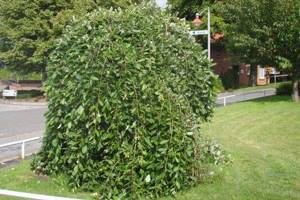
This is a deciduous tree, reaching a height and length of up to 2-3 m. As a rule, it lives no more than 30 years on soils of any moisture content. The variety is shade-tolerant and light-loving. For normal growth, abundant watering is required. But to avoid overflowing, a fairly high drainage layer should be laid. The plant is frost-resistant, but it is recommended to cover the trunk for the winter.
The advantage of the plant, we repeat, is the tent-shaped weeping crown. Goat willow looks great on a trunk. Of the many varieties, pendula can be identified by its dark green oblong-elliptical foliage up to 8-10 cm long. In autumn, the color turns yellow.
In April-May, flowering begins (lasting 15 days) with the release of flat golden-yellow catkins. Subsequently, the fruit is formed in the form of a box.
In landscape design, pendula is planted as a single tree or in decorative groups. Looks great in rock gardens and near ponds. It goes well with dwarf trees of coniferous varieties, young plants, moisture-loving plants and ground covers. As for reproduction, the procedure is performed by grafting onto a standard.
The most difficult to care for is pruning the goat willow variety Pendula. If the crown is not formed correctly during the first year, the branches will fall to the ground and the decorative value will be lost.
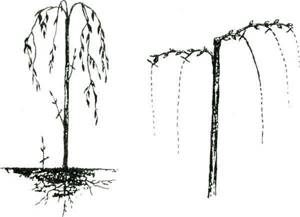
In young animals, all branches are pruned, leaving a length of only 15 cm. In this case, a bud should remain, looking to the side or upward. But not inside the crown. This haircut achieves a shape similar to an open umbrella.
If the plant is mature, then pruning is carried out after flowering, shortening the branches by 2/3 of the entire length. This achieves dense branching of the crown.
Goat willow Kilmarnock
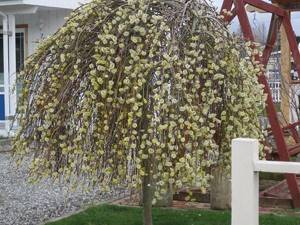
This variety is distinguished by its miniature size (maximum 1.5 m in height). The tree is standard and resembles an open umbrella with branches reaching to the ground. The plant is frost- and wind-resistant, light-loving. It has no soil requirements and grows well on low-calcareous, loamy soils. The only drawback is sensitivity to moisture, so you need to be careful with watering.
The variety can be identified by its foliage. It is green, oblong-elliptical in shape, slightly wrinkled, turning yellow in autumn.
In April, flowering begins with the release of numerous catkins with silvery and fragrant flowers.
Weeping goat willow Pendula.
Willows are not such frequent guests in our gardens. Large, not particularly decorative trees that require a lot of space have long given way to the list of popular garden forms and are more often found in parks than in private properties, and only a few types of willow remain in demand today. But among the diverse and very similar representatives of this family, the weeping form of goat willow “Pendula” stands out for its amazing decorativeness, which today is considered one of the most original weeping representatives of woody plants. The goat willow itself is quite inconspicuous: growing in swamps, on the banks of natural reservoirs and streams, in the lowlands of rivers, the rather pale and modest plant is so loved by goats that it received its eloquent name “goat willow”. But a moisture-loving willow grafted onto a trunk is literally transformed: a massive canopy of hanging branches, superbly contrasting with the lawns and water surface, looks very original and bewitching. This is one of the best small crops for decorating alpine hills and ponds, which captivates with its calm greenery, charming flowering, during which bare arched branches are covered with elongated fluffy earrings of light golden tones, similar to fancy, well-fed caterpillars and a yellow autumn outfit. Let's take a closer look at the amazing weeping goat willow and the peculiarities of its cultivation.
Goat willow (Salix caprea) form “Pendula” is a compact representative of the willow family, which is easily distinguished from other plants by the weeping shape of the crown, grafted onto the trunk and the characteristic color of the leaves. The height of this plant will not exceed one and a half meters, while the diameter of the crown is limited to 1 meter, which allows this tree to be used in landscaping even the smallest gardens. Even relatively rapid growth - about 30 cm per year - does not affect the breadth of use of this type of willow. Deciduous goat willow retains its beauty from early spring until autumn. The oblong, elliptical leaves reach about 10 cm in length and retain an even muted green color from spring until autumn, when they change to a rather bright and uniform yellow. The leaves of goat willow are smooth and dark on top, but underneath they are velvety with a silvery color. Goat willow blooms in May, when sparsely spaced large, thick, seemingly fluffy golden catkins appear on the branches. Unusual earrings and fruit boxes look charming.
Goat willow form “Pendula” cannot be called a whimsical plant. It grows well in any soil with sufficiently bright light. The only thing this weeping standard beauty will need is regular and fairly abundant watering. To avoid the risk of root rotting, a thick layer of drainage should be laid in the soil. Weeping goat willow copes well with even the most severe frosts and needs to cover the trunk only during snowless winters with strong temperature changes.
The most difficult part of caring for weeping goat willow is pruning. Special procedures in the first years of cultivation are the key to the decorative appearance of goat willow, which without proper preparation will never achieve pomp and the necessary outlines. If a young plant is not formed correctly, its branches will literally fall to the ground in one season. In the first years, do not spare even small seedlings and cut off all the shoots, leaving only about 15 cm with one bud at the end, which necessarily looks not into the crown, but up and to the side, forming a crown that looks like a uniform umbrella of short branches.
Mature trees are pruned only after flowering, shortening the shoots by at least two-thirds of their length. Thanks to this rather drastic pruning, the willow begins to branch densely, and the crown becomes uniquely dense. There is no need to worry about flowering next year: over the summer, new shoots strong enough for spectacular flowering will have time to fully form. Old goat willows or those that are too thick and sloppy in appearance also need rejuvenating pruning. It is also carried out only after flowering, and not in spring or autumn, as usual. Without regular pruning, a weeping goat willow grafted onto a standard will never look attractive, it will become bare inside and lose the effect of a lush canopy.
Goat willow is propagated exclusively by grafting onto a standard. It is quite difficult to obtain plants yourself; they often die, so if you want to plant goat willow of the Pendula form, it is better to purchase a seedling adapted to your area from a nursery.
In landscape design, goat willow in a weeping form is used both for single, solo parts, and for group compositions. It looks great near bodies of water, in all types of rock gardens. Goat willow goes well with all moisture-loving plants, traditional perennials for decorating coastlines, ground covers, and ornamental grasses that maintain the shape of the crown. This willow looks good with dwarf conifers and evergreen species, which emphasize the “fragility” of the crown in winter and spring.
indasad.ru
Goat willow: planting and care

Planting is carried out with the onset of spring. The cuttings are placed in water in advance and wait until the roots appear. Afterwards, they should be transplanted into open ground, after digging a shallow hole. The extracted soil is mixed with compost, and after planting the cuttings are poured into the hole and the soil is slightly pressed down. Afterwards, water the plant well. Subsequently, watering is performed 2-3 times/week. For adult specimens, regular watering is not necessary. If the weather is dry and hot in the summer, the seedlings should be watered more often.
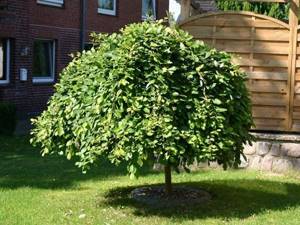
As for feeding, in the spring-autumn period it is carried out twice using complex means. In autumn, give preference to potassium sulfur or superphosphate. If there are a large number of weeds around the tree, mulch with sawdust, peat, expanded clay, paper, and crushed pebbles.
If the soil near the goat willow dries out quickly, loosening should be carried out, and if cracks appear, the soil should be watered first and then loosened.
Don’t forget about timely and regular tree trimming.
Proper planting, watering control, and pruning will help you form a beautiful plant that will add grace to the landscape design of your home.
The use of goat willow in folk medicine
The culture has found its application in various spheres of life : its branches are used for weaving baskets, and the crushed bark is used for tanning leather.
However, besides this, it plays a significant role in folk medicine. For example, decoctions of goat willow leaves, which contain medicinal properties, are excellent mouth rinses for the treatment of gum diseases and stomatitis. Rakita can relieve a person of calluses and normalize the functioning of the sweat glands. And also its use has a wound-healing, choleretic, antipyretic, and calming effect. If a person has symptoms of gallbladder disease, rheumatism, or just a cold cough, then you can safely prepare a healing decoction from goat willow bark. To do this, pour 20 g of crushed bark with a glass of boiling water. Boil the well-mixed mixture for half an hour in a water bath. After removing from heat, let sit for 15 minutes. After straining, the decoction is ready for use, two tablespoons three times a day.
So, goat willow is, first of all an excellent ornamental plant used in landscape design to form fabulous garden compositions. Secondly, the culture has many medicinal properties. By planting a crop on his plot, a person will be able to combine a lot of useful qualities in one tree.









